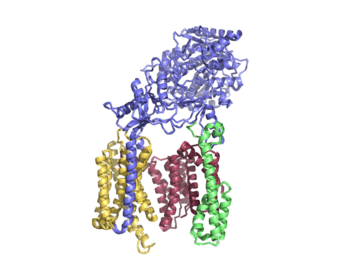User:Daniel Mulawa/Sandbox 1
From Proteopedia
(Difference between revisions)
| Line 7: | Line 7: | ||
===Background=== | ===Background=== | ||
| - | Gamma Secretase is a transmembrane aspartate protease | + | Gamma Secretase is a transmembrane aspartate protease. It catalyzes peptide bond hydrolysis of type I integral membrane proteins such as Notch, APP, and various other substrates. It recognizes and catalyzes the reaction with its substrate using 3 residue segments. These substrates generate amyloid-β (Aβ). This product is important for various neural processes, and it is well known for its Implications with Alzheimer’s disease (AD). This has made gamma secretase a popular drug target, specifically using gamma secretase (GS) inhibitors. However, due to the nature of gamma secretase having various neural functions, there are dangerous side effects when it is inhibited. |
| - | + | ||
| - | + | ||
| - | 3 residue segments | + | |
| - | + | ||
| - | + | ||
| - | Implications with Alzheimer’s disease (AD) | + | |
| - | + | ||
| - | GS inhibitors | + | |
| - | + | ||
===Overall Structure=== | ===Overall Structure=== | ||
20 transmembrane components (TMs) | 20 transmembrane components (TMs) | ||
Revision as of 20:30, 24 March 2020
Gamma Secretase
=Human Gamma Secretase=
| |||||||||||
References
1.Bai X, Yan C, Guanghui Yang, et al. 2015. An atomic structure of human γ-secretase. Nature. 525:212-217. 2.Carroll CM, and Li YM. 2016. Physiological and pathological roles of the γ-secretase complex. Brain research bulletin. 126:199-206. 3.Yang G, Zhou R, Shi Y. 2017. Cryo-EM structures of human γ-secretase. Current Opinion in Structural Biology. 46:55–64. 4.Yang G, Zhou R, Zhou Q, et al. 2019. Structural basis of Notch recognition by human γ-secretase. Nature. 565: 192-197. 5.Zhou R, Yang G, Guo X, et al. 2019. Recognition of the amyloid precursor protein by human γ-secretase. Science. 363:1-8.
Student Contributors
Layla Wisser Daniel Mulawa

